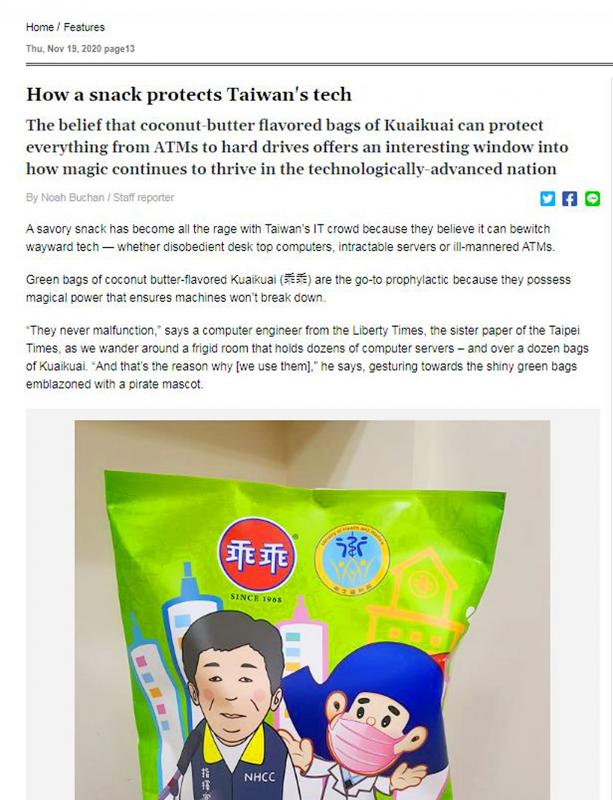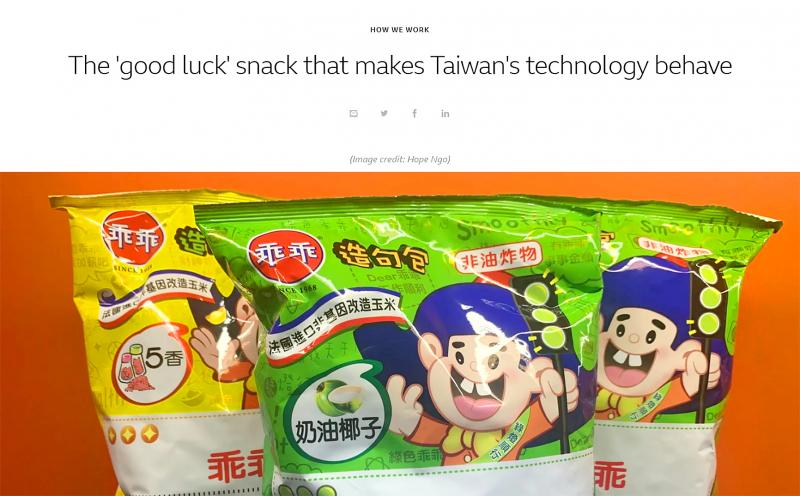After the BBC published “The ‘good luck’ snack that makes Taiwan’s technology behave” on April 16, the Taiwanese media predictably gave it wall-to-wall coverage.
“BBC reveals magical use of Taiwan’s ‘Green Kuaikuai.’ Netizen: ‘State secrets discovered!’” blared the Apple Daily.
“BBC reports on the mystical phenomena of Taiwan’s ‘treasure in the machine,’” wrote CNA.

Photo: Screengrab
“BBC decodes ‘TSMC [Taiwan Semiconductor Manufacturing Co, 台積電] myth’ and talks about the legend of green Kuaikuai,” said ETToday.
The reports framed the story as though a BBC reporter had somehow “discovered” that Taiwanese use the snack Kuaikuai as a talisman to protect their tech. The problem is the BBC didn’t “decode” anything. Rather, their reporter, Hope Ngo, plagiarized the ideas and arguments from a feature, “How a snack protects Taiwan’s tech,” I published in November last year. How do we know this? Because the insight that Taiwanese use Kuaikuai as a talisman requires exhaustive knowledge of Taiwan’s folk culture — knowledge that I’ve cultivated over the past 15 years.
BREAKING THE GOLDEN RULE OF JOURNALISM

Photo: Screengrab
The golden rule of journalism is that you don’t copy the words or ideas of other reporters. I’m not going to lecture the BBC or test the patience of the reader with how fundamental this is to journalistic ethics. (“Google it!”). As Wall Street Journal reporter Benjamin Mullin writes in a plagiarism for dummies explainer in the US-based nonprofit Poynter Institute of Media Studies: “Is the article a complete retread of another story, with little new insight?” Taking this measure as our starting point, let’s examine some of the evidence before us.
The following items compare passages/quotes taken from the Nov. 19 Taipei Times (TT) article and the BBC article, published on April 16.
Firstly, although my headline is shorter and pithier, there is little difference between it and the one found on the BBC.
Taipei Times headline:
How a snack protects Taiwan’s tech
BBC headline:
The ‘good luck’ snack that makes Taiwan’s technology behave
Further investigation in the body of the story shows that the BBC’s central idea — why the snack provides protection to Taiwan’s tech — is no different than my earlier argument.
TT article:
“More than just a meme, passing fad or good luck charm, the belief that the snack keeps tech running smoothly and provides protection offers a window into how folk traditions dating back to antiquity continue to evolve in technologically-advanced Taiwan.
BBC article:
“... how did this savory product end up assuming near-mythical protective properties and, in a technologically advanced society that supplies most of the world’s semiconductors, why exactly do people buy into it?”
The BBC, following my obvious lead, does this in three ways: by linking the color green to machines working properly, Kuaikuai itself being perceived as a talisman and the industries that use the product. And, the quotes given by Kuaikuai general manager, Irene Liao (廖宇綺), are almost word for word the same as those found in my story.
TT on talismans:
Green bags of coconut butter-flavored Kuaikuai are the go-to prophylactic because they possess magical power that ensures machines won’t break down ...”
BBC on talismans:
People see these crisps as amulets — or good luck charms — that, if used properly, will ensure that technology behaves well and doesn’t break down.
TT on why green is an important color:
“Green is associated with traffic lights or the green light on a computer, signifying that everything is flowing smoothly ...”
BBC on why green is an important color:
“... there is a general assumption that green is synonymous with ‘go’, as it would be on a traffic light — so the student put the bag on his computer.”
TT article quoting Liao:
“Apparently there was a student working on his Master’s thesis and he was having problems with his computer. So he came up with the idea that taking a bag of green Kuaikuai and putting it on the computer...”
BBC article quoting Liao:
“It apparently all started with this graduate student who was working on his thesis and his computer kept crashing. So, he had the idea that his device might have needed a talisman...”
TT on who uses Kuaikuai:
Researchers at Academia Sinica, Taiwan’s top research institute, for example, place bags of Kuaikuai in their labs; nurses tape them to respirators and other life-saving devices to ensure that they don’t break down;
BBC on who uses Kuaikuai:
They place bags of this humble snack ... on or around vital machines in many of the island’s laboratories, banks and even hospitals to ensure the machines continue to do their jobs.
EDITORIAL ETHICS
And so on. Ngo’s story about Kuaikuai is a textbook example of what Mullin calls “idea theft,” the practice of “relying too heavily on another journalist’s original story ideas and concepts.”
According to the BBC Blog, “At a fundamental level the audience should be in no doubt when we are reporting things that we have witnessed directly or those seen by others.” The blog further states that: “Attribution alone is not enough. It is also important that when we follow up on someone else’s story we give them due credit.”
Ethical journalistic practice means that editor do their due diligence when receiving a pitch/copy-editing a story, by ensuring that original journalism isn’t copied. A simple Google search would have turned up my article — it’s easy to find. This means that the editor(s) who accepted the pitch/copy-edited the story didn’t do this. Or worse, they did but didn’t think that the story rose to the level of plagiarism.
I sent a complaint to the BBC on Monday last week. As of press time they have yet to respond. (They say they need two weeks to respond to complaints, though one would think that when accused of plagiarism they’d act more quickly.)
Several colleagues and acquaintances got in touch with me immediately after the BBC’s story was covered by local media. They did so for two reasons. To point out its similarity to my story and to remark on the insecurities of the nation’s media ecosystem: when I published my report it spread wildly among social media. It was completely ignored by the many Taiwanese outlets that reported on the BBC article.
As one writer wrote on a Facebook thread discussing why my article was ignored: “Foreign farts are more fragrant.”
I’ve spent many years writing extensively about Taiwan’s popular folk religion, and this isn’t the first example of a foreign outlet pilfering one of my stories. But it’s probably the most egregious.

May 26 to June 1 When the Qing Dynasty first took control over many parts of Taiwan in 1684, it roughly continued the Kingdom of Tungning’s administrative borders (see below), setting up one prefecture and three counties. The actual area of control covered today’s Chiayi, Tainan and Kaohsiung. The administrative center was in Taiwan Prefecture, in today’s Tainan. But as Han settlement expanded and due to rebellions and other international incidents, the administrative units became more complex. By the time Taiwan became a province of the Qing in 1887, there were three prefectures, eleven counties, three subprefectures and one directly-administered prefecture, with

It’s an enormous dome of colorful glass, something between the Sistine Chapel and a Marc Chagall fresco. And yet, it’s just a subway station. Formosa Boulevard is the heart of Kaohsiung’s mass transit system. In metro terms, it’s modest: the only transfer station in a network with just two lines. But it’s a landmark nonetheless: a civic space that serves as much more than a point of transit. On a hot Sunday, the corridors and vast halls are filled with a market selling everything from second-hand clothes to toys and house decorations. It’s just one of the many events the station hosts,

Two moves show Taichung Mayor Lu Shiow-yen (盧秀燕) is gunning for Chinese Nationalist Party (KMT) party chair and the 2028 presidential election. Technically, these are not yet “officially” official, but by the rules of Taiwan politics, she is now on the dance floor. Earlier this month Lu confirmed in an interview in Japan’s Nikkei that she was considering running for KMT chair. This is not new news, but according to reports from her camp she previously was still considering the case for and against running. By choosing a respected, international news outlet, she declared it to the world. While the outside world

Through art and storytelling, La Benida Hui empowers children to become environmental heroes, using everything from SpongeBob to microorganisms to reimagine their relationship with nature. “I tell the students that they have superpowers. It needs to be emphasized that their choices can make a difference,” says Hui, an environmental artist and education specialist. For her second year as Badou Elementary’s artist in residence, Hui leads creative lessons on environmental protection, where students reflect on their relationship with nature and transform beach waste into artworks. Standing in lush green hills overlooking the ocean with land extending into the intertidal zone, the school in Keelung